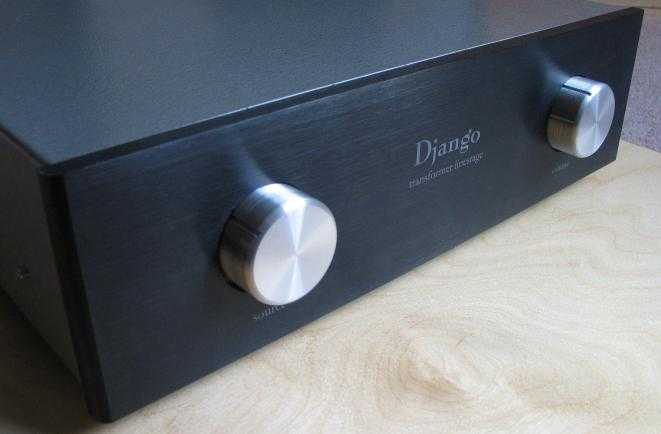

Product: Django TVC passive
preamp
Manufacturer: DIY Hifi Supply, Hong Kong
Price: $600-$1200 kit, $150 extra for fully assembled unit
Reviewer: Maarten van Casteren - TNT UK
Date: September 2006
A long time ago, in an analogue era far away, preamps were complicated things, with volume, balance, tone and loudness controls. They also had phonostages, tape loops and outputs for headphones. Clearly there was a reason for the existence of such a component. But nowadays it seems the reasons for having a separate preamp are more difficult to see. In almost all cases the source components have an output level that is more than what is needed to produce dangerously high sound levels from the power amp. So the pre 'amplifier' spends its time actually attenuating the signal. This can easily be done by a simple potentiometer. Add a switch and you have all the features of most modern preamps: source selection and volume control. Why make things more complicated? And indeed a passive preamp, as such a device is called, can be an extremely effective solution. Negligible noise and distortion (in theory) and the simplest possible signal path. Why use an ordinary, active preamp at all?
Well, the reason is that output level is only part of the story. Just providing enough voltage isn't enough. Input and output impedance are just as important for a preamp to work well. Sources want to see a high input impedance and power amps like to be driven from a low output impedance. And that's where passive preamps go wrong. Input impedance will normally be on the low side, while output impedance is usually much higher than with an active amp. Try to up the input impedance, and the output one will go up too. The optimal value will always depend on the specific source and power amp used, and the match will always be worse than between the source and power amp themselves.
This is not to say that passive preamps cannot work well. In the right context they can work brilliantly. They're famously transparent, quiet and free of distortion. But it all depends on the source and power amp. And the cables, as the less-than-optimal impedance match will make passive preamps very sensitive to the properties of the interconnects used.
But, since a few years, a different type of passive preamp has been available. They're known as TVC: Transformer Volume Control. Instead of relying on resistive potentiometers, this type uses a transformer to attenuate the signal. A potentiometer, even a fancy stepped one, will attenuate the signal by turning most of it into heat and passing on the rest. A transformer on the other hand will not waste any energy, except for some minor losses. The voltage will be lowered, but it will be traded for current. Basically, this means that the impedance match between source and power amp will be improved, instead of worsened, as long as you attenuate the signal. And in almost all cases the signal will be attenuated, making this a solution that has some serious theoretical advantages over the classic resistive passive preamp.
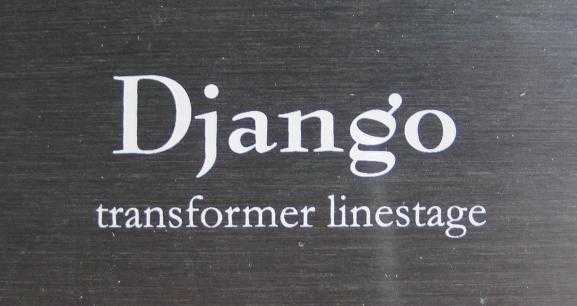
The Django preamp from DIY Hifi Supply is such a device. It is available in kit form, as well as fully assembled. There's a choice of three TVC's: the Stevens & Billington TX102, an amorphous core TVC or an autoformer. I was told that the S&B version was more transparent and neutral. This TVC is also used in a number of other passive preamps, for example the Music First Audio preamp and the Audio Zone Pre-T. For those reasons I chose to review the S&B version. All other options were the top-spec ones, with pure silver internal wiring, Seiden switches and silver-plated phono sockets. The preamp was build for me by DIY Hifi Supply and even came partly burned in. A new version of the Django has just been released, which features remote control. It is based on the same TVC technology, so should have the same sonic properties as the review sample.
Now, as a name DIY Hifi Supply has somewhat less of a ring to it than, let's say, Krell or Martin Logan. But, what's in a name? The company, of about 5 people, is based in Hong Kong and sells mostly over the internet. They started with 3 kits that were discontinued retail products from the Opera (Consonance) company in China but offered upgraded parts and circuit topologies. Very soon, with the help of Thorsten Loesch (who used to be a TNT Audio reviewer b.t.w.), they developed their own products, like the Django. Thorsten is credited for persevering in getting Stevens and Billington to produce a state-of-art and reasonably priced TVC. Next to the Django there's also an active preamp and a series of power amps, all using valves. At the moment DIY Hifi Supply sells about 50% kits and 50% custom built components.
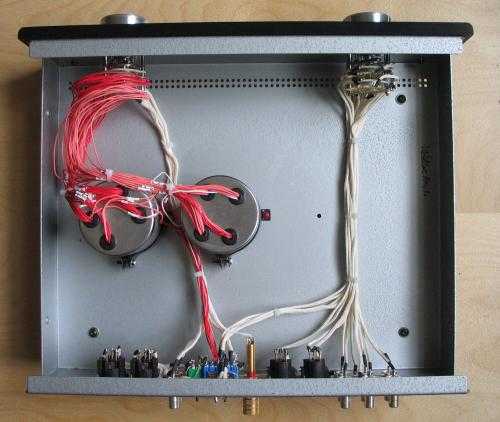
First impressions were very good. The case is bigger than you would expect, given the minimal content. It is 6 or 7 cm narrower than a standard component, but about 10 cm high. It also stands quite high on nicely dampened feet. The front is a thick slab of aluminium, while the rest of the case is steel. The knobs are made of stainless steel and make a stylish contrast with the black anodised aluminium front plate. Both source selector and volume have a very good and positive feel to them. No cheap light-weight switches here, but a top-quality tactile feel. The inside looks very well made and organised. The actual transformers are bigger than I expected, and explain why the Django's case is as high as it is.
There are 4 inputs, 3 RCA and one balanced, all line-level. Output can be set to either RCA or balanced with a selector at the back. The balanced input is not actually a real balanced input: only one side is used. I think that is a bit of a missed opportunity, as TVC's are, by their nature, the perfect devices to convert balanced into single ended or the other way around. I only have a single ended source, but if you use both types of sources and/or power amps, a preamp that can mix and match these in any way you like would be a fabulous solution. But it would involve an extra input switch and some more internal wiring, so I can see why DIY Hifi Supply have chosen a more simple solution. The Music First Audio preamp does offer this, by the way, but is is also considerably more expensive. Two more switches at the back enable a 6 db higher output level and three different ways to connect the grounds of source and power amp. This last option is a specific feature of a TVC preamp. With transformers doing the attenuation ther is actually no electric connection between the source and power amp. The switch has three settings: disconnected, connected, and connected through a 1.5 kOhm resistor. Disconnecting grounds will break any earth loops and can prevent hum and noise.
Volume can be controlled in 20 steps. Maximum attenuation is 46 db, which isn't much compared with other preamps. On top of that the first two steps are 6 db. The rest are 2 db, which is fine. With my Micromega stage 3 CD player and Electrocompaniet ECI-2 amp the lowest volume setting is already a bit on the loud side for background music, although I actually never felt the need to play softer than that. The first two steps are really a bit too big for my taste, but it wasn't a real problem. Had I had more sensitive speakers I might have had a little bit of a problem, though, although it could always be solved with some inline attenuators, I guess.
When I first connected the Django and switched on my power amp, a very loud hum emerged from the speakers. It woke up my children, who were sleeping in their room upstairs! It turns out that the grounding switch was in the 'disconnected' position. And both my source and power amp have 'floating' power supplies. Now, this is quite rare, and Electrocompaniet are in fact very proud of their Floating Transformer Technology, but in this case it caused my system to almost self-destruct. Luckily everything survived and after flipping the grounding switch and (slightly nervously) switching the power amp on again, everything seemed to work perfectly. No trace of noise or hum anymore and the preamp functioned flawlessly from then on. The annoying thing is that the three positions of this switch aren't labeled at the back, so you will have to consult the manual to find out which position to use.
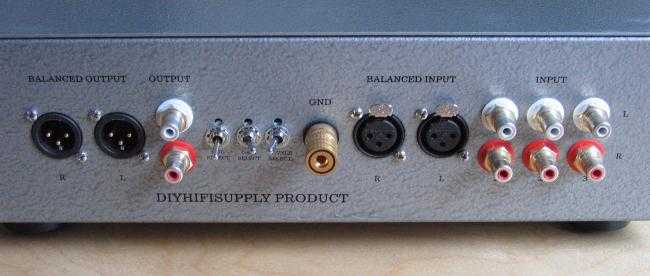
The sound of the Django immediately impressed me. My Electrocompaniet is an integrated amplifier, but can be used as a separate pre and power amp. The preamp section is passive and consists of some (relay) switches and a pair of Alps blue potentiometers for volume and balance. So in fact I was just replacing one passive preamp with another. And the internal Electrocompaniet one had the advantage of being much closer to the power amp as it actually is on the same PCB. Still, the sound did improve. The first thing that I noticed was a clear increase in attack. Piano, percussion and even applause sounded snappier and better timed. This effect was present over the whole spectrum, with even bass better articulated and easier to follow. At the same time the whole reproduction was cleaner and sweeter, with a certain glare removed. Bass also seemed a little bit dryer, but with more drive and clarity. Overall, the whole picture was more alive and sounded more natural and present. And it continued to improve over the next weeks, with the sound becoming warmer and more articulate over time.
A feature of TVC preamps is supposed to be their better performance at lower volume levels. In a normal preamp the signal will be attenuated enormously and then amplified again by the active output stage. This means that the signal will be extremely weak at a certain point, which could potentially harm the lowest level components of the music. When listening to piano I did find that softly played bass notes still had the full body and weight of the whole piano behind them. Normally these sound a bit thin, but the Django managed to make them sound convincing.
I took the Django to a friend to compare it to his NVA passive preamp. This was driving a NVA P60 power amp. This pre/power combination was highly regarded at the time, which was about 8 years ago. When we switched to the Django we noticed clear improvements again. Bass was tighter and the whole presentation was more musical and natural. There was more detail, especially in the lower frequencies. Not an enormous difference in any specific respect, but it certainly added up to a better sound overall. In spite of the volume levels being matched to within 1 dB the Django initially seemed to sound a bit less loud than the NVA, but that impression soon disappeared. The Django just sounds a bit cleaner and tidier than the NVA, while at the same time having more detail and better dynamics. It didn't matter what music we played: the Django always sounded better. Of course, the NVA power amp is designed to be used with a passive preamp, specifically the NVA one. All the more impressive that the Django still managd to beat it, I think, although the difference wasn't enormous.
I took the Django to another friend who has got an Audio Analogue Bellini and Donizetti pre/power combination and a very nice Audio Analogue Maestro CD player. We first listened to his setup for about an hour and then replaced the Bellini with the Django. Now, the Bellini is a very respectable active transistor preamp and has received many positive reviews, but it is also over 5 years old, and slightly cheaper than the Django. Perhaps this is not a completely fair comparison, but very informative nevertheless.
The first thing we immediately noticed is that the Django has tighter and better controlled bass. Bass lines are easier to follow because of this. The whole soundstage also seems to be bigger and especially deeper than before. The sound is faster and livelier over the whole spectrum too. This was slightly unexpected, as these are more or less the things that active transistor preamps are supposed to be good at.
We played all the tracks we played before with the Bellini, and every track seemed to have a new surprise. After a few tracks it became clear that the Django is much better at communicating the specific atmosphere of each recording. The Bellini made them all sound more the same in comparison. One event is very telling of the difference between these two preamps: We didn't measure and match the volume levels between the two amps. It would have been better, but we didn't have the equipment available, so we guessed. We were quite happy with the volume, until we played 'Walk on the wild side' by Lou Reed. After a minute my friend wanted to get up and change the volume, as he was now convinced it was much lower than before. I stopped him, as we had decided to stick with this setting. The next track we played was 'Apollo' by Alan Parsons (from 'On air'), which is a fast and punchy recording. Very soon after it had started my friend had to run to the system to turn the volume down, as this was sounding very loud indeed, clearly louder than before!
How is it possible that, with the same volume setting, one track seemed to be lower in volume and another much louder? Well, the Lou Reed track is a very relaxed, laid back recording, while the Alan Parsons track is very up-beat and vigorous. And the Django just brings this out. Actually, every track we played on both preamps had much more of its own character on the Django. When we went back to the Bellini it was exposed as sounding a bit flat, slower, grainy and boxed in. It clearly puts its stamp on the sound, where by comparison the Django just seems to let the music flow unrestrained. I was actually very impressed with this: it was able to bring out all the energy and impact of the Alan Parsons track, while the Lou Reed track showed that it could also sound very relaxed, refined and musical. Another difference in 'Walk on the wild side' were the female singers that come in about halfway through the track. They start in the back and gradually move to the front of the sound stage. With the Django they didn't just start from further back, they also came at least half a meter further into the room!
Overall, I think the difference between these two preamps was quite spectacular and a clear victory for the Django. And there were no drawbacks either: it was just better at everything. Specific strong points in comparison to the Bellini were dynamics, soundstage, speed, texture and bass definition.
We also tried the NVA preamp in the same setup with the Donizetti power amp, just to see what another passive pre would do. Sadly, it only showed the limitations of a 'normal' passive preamp, as bass was now completely uncontrolled and very boomy. The rest of the sound seemed OK, but that didn't matter, as the bass spoiled the picture completely. Clearly, the Donizetti power amp didn't like to be driven by a higher impedance source, while it worked brilliantly with the Django.
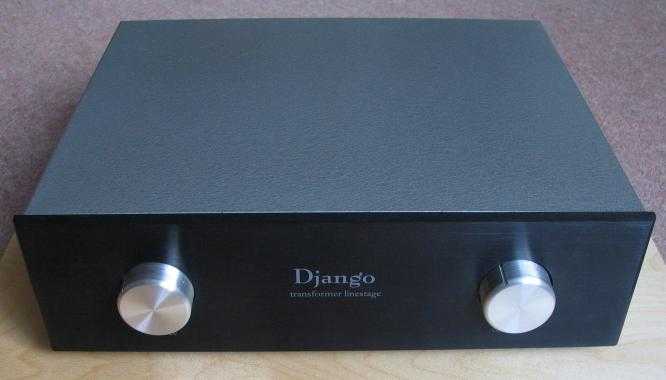
I am very impressed with this preamp. I haven't been able to find any limits to what it can do, and it seems to perform excellently with all three of the systems I've tried it in. The difference with other preamps, both active and passive, was impressive, with the Django always sounding the better preamp with ease. Add to this the fact that is it very easy and pleasant to use, quite affordable and basically unbreakable and you have an almost perfect product. The only flaws are the lack of real balanced inputs, possibly insufficient attenuation in certain contexts and bad labeling of switches at the back. But those are minor points: if you are looking for a really good preamp, try this one, I'm sure you will be amazed. It also happens to be the most affordable TVC preamp on the market, while at the same time feeling very well built and using excellent quality components.
Forget all preconceptions about passive preamps: this one is different. It simply seems to combine all the advantages of active and passive preamps, and sound-wise it is absolutely unbeatable at the price. I actually liked it so much that I couldn't bear seeing it leave and bought the review sample. I'm sure I'm going to enjoy this little preamp for a very long time. Very highly recommended.
Thanks for the great review and the efforts made to compare in other systems with other listeners present. Although the particular brand of transformer does much to shape the sound of a TVC, we have found other contributing factors:
1. Case. We started with a small steel chassis and it sounded good but when we went to the larger chassis (larger than needed to contain the parts) the sound was noticeably better. Considering this is an inductive device may explain that. The new Django+ uses a non-magnetic chassis.
2. Switches. Rubbish switches noticeably degrade transparency. Of the ones we tried, Seiden (which is gold on silver) has the best transparency and doesn't have the sterile sound caused by some other high end switches. Gain and grounding switches are also high quality Miyama from Japan.
3. Wire and connectors. It really is noticeable. We found soft annealed silver wire and and silver RCA connectors to give the greatest smoothness and transparency.
© Copyright 2006 Maarten van Casteren - www.tnt-audio.com